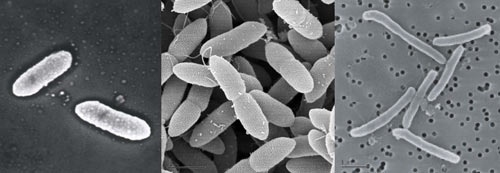DOE JGI will be sequencing three biogeochemically important bacteria, Diaphorobacter sp. strain TPSY, Ferrutens nitratireducens strain 2002 and Azospira suillum strain PS. These organisms represent diverse genera capable of anaerobically oxidizing both iron(II) and humic acids by using nitrate as the electron acceptor. Two of these organisms, strain 2002 and strain TPSY, are also capable of the anaerobic nitrate-dependent oxidation of uranium(IV) to uranium(VI).

Left to right, Azospira suillum PS, Ferrutens nitratireducens 2002, and Diaphorobacter TPSY.
Nitrate-dependent microbial metal oxidation is of critical importance because of its potential effect on the fate and transport of radioactive contaminants. Nitrate-dependent Iron(II) oxidation by organisms such as these offers a unique and robust alternative for the immobilization of toxic heavy metals and radionuclides in contaminated sites. Furthermore, recent studies investigating biological oxidation of immobilized tetravalent uranium have demonstrated that anaerobic uranium(IV) bio-oxidation coupled to the reduction of nitrate presents a microbial metabolism that can potentially reverse and/or inhibit any reductive uranium remediation strategy via the subsequent remobilization of uranium. The ability of Diaphorobacter sp. strain TPSY and Ferrutens nitratireducens to oxidize uranium(IV) to uranium(VI) and resolubilize the immobilized uranium raise important questions regarding the long-term stability of immobilized uranium in the environment. Although each of these metabolisms represent significant controls on the fate and transport of uranium in the environment, nothing is yet known of the proteomic or genomic processes involved. The sequencing of the genomes of these three model nitrate-dependent metal-oxidizing organisms will allow a significant advancement in our understanding of these critical biogeochemical processes.
Principal Investigators: John Coates (Univ. of California, Berkeley)